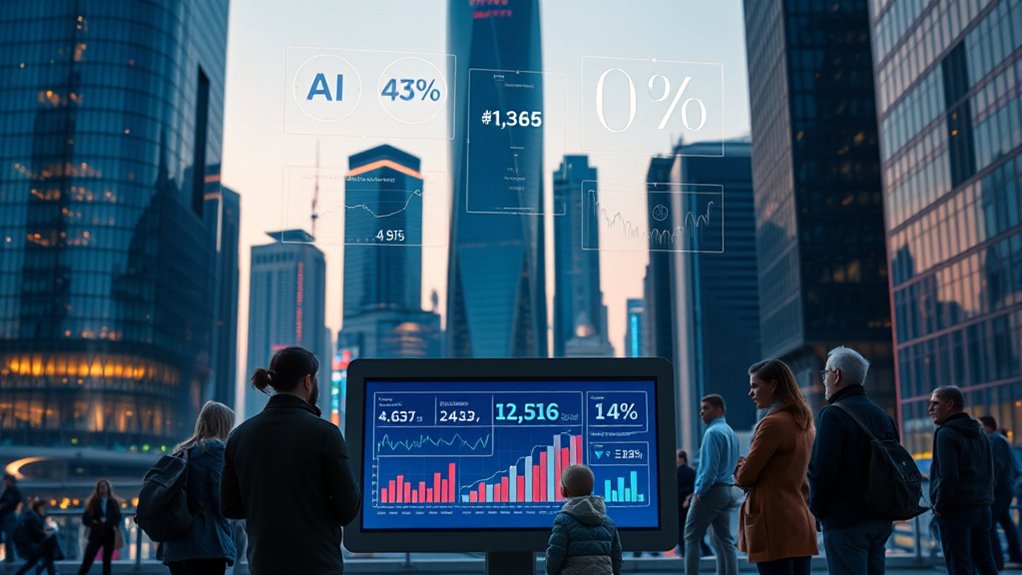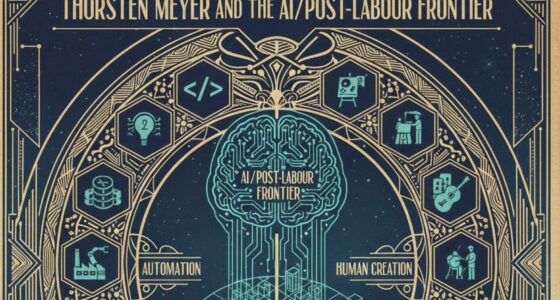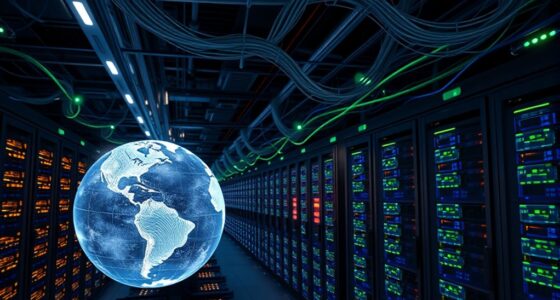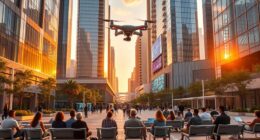AI is indeed intensifying economic inequality by quickly displacing vulnerable and low-skilled workers worldwide, especially in wealthy nations that adopt it faster. Automation leads to job losses in fields like manufacturing, entry-level roles, and white-collar jobs, often without clear paths to retraining. This growing divide deepens social gaps and limits opportunities for those most at risk. To better understand how AI‘s impact varies globally and what you can do about it, keep exploring the facts behind this complex issue.
Key Takeaways
- AI-driven job losses are significant, especially in tech, manufacturing, and white-collar roles, impacting inequality across sectors.
- Wealthier nations adopt AI faster, often leading to increased domestic inequality and offshoring to less developed countries.
- Automation tends to displace entry-level and vulnerable workers, deepening skill gaps and social mobility challenges.
- The perception of widespread job loss from AI is amplified, but some new roles may emerge, though inequality may persist or worsen.
- Cybersecurity risks and uneven AI deployment contribute to global disparities, making inequality a complex and ongoing issue rather than a myth.

Have you ever considered how artificial intelligence is reshaping the job market—and who benefits or suffers from these changes? In 2025 alone, AI caused nearly 78,000 tech job losses, averaging about 491 layoffs every day. Major companies like Microsoft and IBM have cut thousands of jobs, mainly targeting roles in HR and engineering, aiming to replace entire functions with automation rather than just cutting costs. This shift isn’t limited to a few firms; around 41% of employers worldwide plan to reduce their workforce due to AI within the next five years, often acting immediately. As a result, AI-driven layoffs threaten to displace millions, especially those in entry-level and white-collar jobs, by automating tasks traditionally performed by less experienced workers.
You might not realize it, but AI is also shrinking entry-level opportunities. Tasks that once provided a stepping stone into the workforce are now being automated, reducing chances for young or inexperienced workers to gain valuable experience. Over time, nearly 50 million jobs in the U.S. could be affected, with the remaining roles experiencing downward pressure on salaries since fewer hires are needed to handle more work. This creates a ripple effect, intensifying competition for jobs overseas, especially as U.S. firms outsource roles to countries like India, deepening inequality in white-collar sectors. Such dynamics hinder social mobility and make it harder for individuals from disadvantaged backgrounds to climb the economic ladder.
More companies are replacing human workers with AI tools—about 30% in the U.S., a figure expected to grow to 38% in 2025. Many prioritize automation over augmenting human work, which means more displacement. Since 2000, automation has wiped out 1.7 million manufacturing jobs, illustrating a long-term trend of structural disruption. About 13.7% of U.S. workers report losing their jobs to robots or automation, with perceptions of job loss varying across different groups. The widespread fear of displacement skews workers’ views, inflating estimates of how many jobs have been lost to AI, fueling a sense of insecurity.
Globally, AI’s impact isn’t uniform. Wealthier nations tend to implement AI faster, often resulting in job cuts, while offshoring to lower-cost regions like India amplifies inequality. Vulnerable groups—such as younger workers and those with fewer skills—face disproportionate hardships, as mismatched skills and limited access to retraining widen the divide. Additionally, the cybersecurity vulnerabilities introduced during major outages, like the recent Microsoft outage, can further destabilize digital infrastructure and increase risks for users and organizations alike. Though some forecasts suggest AI may create new roles, the overall picture shows a landscape where inequality deepens, leaving many behind amid rapid technological change.
Frequently Asked Questions
How Does AI Impact Income Distribution Globally?
You see that AI impacts income distribution globally by benefiting the wealthy and highly skilled, often widening existing gaps. As AI boosts productivity mainly for rich countries and top earners, lower-income groups and developing nations struggle to keep up. This can lead to increased inequality both within countries and across borders, making it harder for poorer populations to share in AI’s gains without targeted policies.
Can AI Help Reduce Economic Inequality?
You might wonder if AI can help reduce economic inequality. It has the potential to disrupt high-income jobs, boost productivity, and create new employment opportunities, especially if managed well. However, benefits often favor the wealthy and those with digital access, which can widen gaps. To guarantee AI truly reduces inequality, policies like equitable access, education, and regulation are essential to make its advantages more inclusive.
What Policies Are Needed to Regulate Ai’s Societal Effects?
Imagine a city skyline dotted with shining lights, each representing a policy guiding AI’s impact. You need robust data privacy laws to shield personal information, clear transparency rules to see how decisions are made, and strong regulations to prevent bias. Investing in education and fostering international cooperation help build a balanced future. By actively implementing these policies, you can guarantee AI benefits everyone, creating a fairer society for all.
How Vulnerable Are Marginalized Communities to AI Bias?
You’re vulnerable to AI bias because the data used to train AI often reflects societal prejudices, leading to discriminatory outcomes. Marginalized communities face limited access to jobs, credit, and opportunities as AI systems reinforce existing inequalities. Without diverse representation in tech and proper regulations, these biases persist, making it harder for you to achieve fair treatment and equality. Addressing this requires inclusive development and active efforts to mitigate bias.
What Are the Ethical Considerations in AI Deployment?
You need to consider several ethical issues when deploying AI. Focus on avoiding bias and discrimination by using diverse data, ensuring transparency with explainable decisions, and maintaining privacy and data security. You should also establish clear accountability, involve stakeholders, and promote fairness and inclusivity. Regularly audit and evaluate AI systems to address ethical concerns, follow regulations, and develop policies that uphold human rights, ensuring responsible and equitable AI use.
Conclusion
So, here’s the irony: as AI promises to bridge gaps, it often deepens them instead. You might think technology’s a great equalizer, but in reality, it’s just another tool that can widen the divide if we’re not careful. Instead of solving inequality, AI risks becoming a mirror reflecting society’s flaws—highlighting what we’d rather ignore. So, next time you hear AI’s fixing everything, remember, it might be just exposing what we refuse to change.









